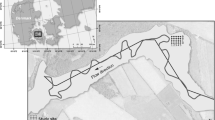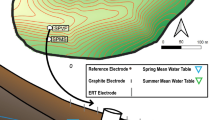Abstract
Knowledge of wetland hydrology, soil redox potential, pH, and temperature dynamics are key components required to understand the capacity of tidal wetlands to function, in particular to attenuate agrichemicals. In a freshwater tidal wetland along the James River in Virginia, USA, redox potential, pH, water-table level, and soil temperature were monitored continuously at two depths (20 and 50 cm) at three sites during a 12-month period from September 1, 1997 to August 31, 1998. Redox potentials were at or below − 150 mV (methanogenic or sulfate reducing conditions) at the 50-cm depth during the entire monitoring period. At the 20-cm depth, redox potentials remained highly reducing 95% of the time. The soil is continuously wet throughout the year, with the water-table level above the 20-cm soil depth for 95% of the time. Water-table level or hydrology was the primary factor controlling fluctuations in the redox state. Soil pH values were generally between 6 and 8, and they dropped 1 pH unit upon an oxidation event, which was reversible. Soil temperature at the 50-cm depth never dropped below 5° C, indicating a year-round biological activity season. This wetland supports a large diversity of plant species. Permanently reduced sub-surfaces, year-round biological activity, and large organic matter accumulations are characteristic features of this freshwater tidal wetland.
Similar content being viewed by others
Literature Cited
Austin, W. E. and J. H. Huddelston. 1999. Viability of permanently installed platinum redox electrodes. Soil Science Society of America Journal 63:1757–1762.
Bartlett, R. J. and B. R. James. 1995. System for categorizing soil redox status by chemical field testing. Geoderma 68:211–218.
Bohn, H. L. 1971. Redox potentials. Soil Science 112:39–45.
Bohn, H., B. McNeal, and G. O’Connor. 1979. Soil Chemistry. John Wiley & Sons, New York, NY, USA.
Bowden, W. B., C. J. Vorosmarty, J. T. Morris, B. J. Peterson, J. E. Hobbie, P. A. Steudler, and B. Moore III. 1991. Transport and processing of nitrogen in a tidal freshwater wetland. water Resources Research 27:389–408.
Chabreck, R. H. 1972. Vegetation, water and soil characteristics of the Louisiana coastal region. Louisiana State University and Agricultural Experiment Station Bulletin 664.
Chung, K. H., K. S. Ro, and D. Roy. 1995. Atrazine biotransformation in wetland sediment under different nutrient conditions-I: Anaerobic. Journal of Environmental Science and Health A 30: 109–120.
DeLaune, R. D. and S. R. Rezeshki. 1991. Role of soil chemistry in vegetative ecology of wetlands. Trends in Soil Science 1:103–113.
de Mars, H. and M. J. Wassen. 1999. Redox potentials in relation to water levels in different mire types in the Netherlands and Poland. Plant Ecology 140:41–51.
Edmonds, W. J., R. L. Hodges, and C. D. Peacock, Jr. 1990. Tide-water Virginia tidal wetland soils: a reconnaissance characterization. Department of Crop and Soil Environmental Science, Virginia Agricultural Experiment Station, Blacksburg, VA, USA.
Faulkner, S. P. and W. H. Patrick, 1992. Redox processes and diagnostic wetland soil indicators in bottomland hardwood forests. Soil Science Society of America Journal 56:856–865.
Feijtel, T. C., R. D. DeLaune, and W. H. Patrick, Jr. 1988. Seasonal pore water dynamics in marshes of Barataria Basin, Louisiana. Soil Science Society of America Journal 52:59–67.
Feng, J. and Y. P. Hsieh. 1998. Sulfate reduction in freshwater wetland soils and the effects of sulfate and substrate loading. Journal of Environmental Quality 27:968–972.
Gee, G. W. and J. W. Bauder. 1986. Particle-size analysis. p. 383–411. In A. Klute (ed.) Methods of Soil Analysis: Part 1-Physical and Mineralogical Methods, 2nd ed. Agronomy Monograph 9. American Society of Agronomy and Soil Science Society of America, Madison, WI, USA.
Gilliam, J. W. 1994. Riparian wetlands and water quality. Journal of Environmental Quality 23:896–900.
Haraguchi, A. 1991. Effects of water-table oscillation on redox property of peat in a floating mat. Journal of Ecology 79:1113–1121.
Helling, C. S. 1976. Dinitroaniline herbicides in soil. Journal of Environmental Quality 5:1–15.
Jury, W. A., W. R. Gardner, and W. H. Gardner. 1991. Soil Physics. 5th ed. John Wiley & Sons, New York, NY, USA.
Kaiser, J. P. and J. M. Bollag. 1992. Influence of soil inoculum and redox potential on the degradation of several pyridine derivatives. Soil Biology and Biochemistry 24:351–357.
Lindo, D. L. and J. L. Richardson. 2001. Hydric soils and wetlands in riverine systems. p. 283–300. In J. L. Richardson and M. J. Vepraskas (ed.) Wetland Soils: Genesis, Hydrology, Landscapes, and Classification. Lewis Publishers, Boca Raton, FL, USA.
Madsen, E. L., A. J. Francis, and J. M. Bollag. 1988. Environmental factors affecting indole metabolism under anaerobic conditions. Applied and Environmental Microbiology 54:74–78.
McLean, E. O. 1982. Soil pH and lime requirement. p. 199–224. In A. L. Page, R. H. Miller, and D. R. Keeney (eds.) Methods of Soil Analysis: Part 2-Chemical and microbiological properties. Agronomy Monograph 9. American Society of Agronomy and Soil Science Society of America, Madison, WI, USA.
Megonigal, J. P., S. P. Faulkner, and W. H. Patrick. 1996. The microbial activity season in southeastern hydric soils. Soil Science Society of America Journal 60:1263–1266.
Mitsch, W. J. and J. G. Gosselink. 1993. Wetlands. 2nd ed. Van Nostrand Reinhold, New York, NY, USA.
Moore, P. A. Jr. and K. R. Reddy. 1994. Role of Eh and pH on phosphorus geochemistry in sediments of Lake Okeechobee, Florida. Journal of Environmental Quality 23:955–964.
Mueller, S. C., L. H. Stolzy, and G. W. Fick. 1985. Constructing and screening platinum microelectrodes for measuring soil redox potential. Soil Science 139:558–560.
Nay, M., M. Snozzi, and A. J. B. Zehnder. 1999. Fate and behavior of organic compounds in an artificial saturated subsoil under controlled redox conditions: The sequential soil column system. Biodegradation 10:75–82.
Nelson, D. W. and L. E. Sommers. 1982. Total carbon, organic carbon, and organic matter. p. 539–580. In A. L. Page, R. H. Miller, and D. R. Keeney (ed.) Methods of Soil Analysis: Part 2-chemical and Microbiological Properties. Agronomy Monograph 9. American Society of Agronomy and Soil Science Society of America, Madison, WI, USA.
Odum, W. E. 1988. Comparative ecology of tidal freshwater and salt marshes. Annual Review of Ecology and Systematics 19:147–176.
Odum, W. E., T. J. Smith, J. K. Hoover, and C. C. McIvor. 1984. The ecology of tidal freshwater marshes of the United States east coast: a community profile. U.S. Fish and Wildlife Service, Washington, DC, USA. FWS/OBS-83/17.
Pardue, J. H., R. D. DeLaune, D. D. Adrian, and W. H. Patrick, Jr. 1993. Sorption and degradation of pesticides and organic chemical in soil. Soil Science Society of America, Madison, WI, USA. Special Publication no. 32.
Parr, J. F. and S. Smith. 1976. Degradation of toxaphene in selected anaerobic soil sediments. Soil Science 121:52–57.
Patrick, Jr., W. H. and R. D. DeLaune. 1977. Chemical and biological redox systems affecting nutrient availability in the coastal wetlands. Geoscience and Man 18:131–137.
Patrick, Jr., W. H., R. P. Gambrell, and S. P. Faulkner. 1996. Redox measurements of soils. p. 1255–1276. In D. L. Sparks (ed.) Methods of Soil Analysis: Part 3-Chemical Methods. Soil Science Society of America Book Series: 5. Soil Science Society of America and American Society of Agronomy, Madison, WI, USA.
Plumb Jr., R. H. 1981. Procedures for handling and chemical analysis of sediment and water samples. Environmental Laboratory, U.S. Army of Engineer Waterways Experiment Station. Vicksburg, MS, USA.
Ponnamperuma, F. N. 1972. The chemistry of submerged soils. Advances in Agronomy 24:29–96.
Rabenhorst, M. C. 2001. Soils of tidal and fringing wetlands. p. 301–315. In J. L. Richardson and M. J. Vepraskas (ed.) Wetland Soils: Genesis, Hydrology, Landscapes, and Classification. Lewis Publishers, Boca Raton, FL, USA.
Seybold, C. A., W. Mersie, and C. McNamee. 2001. Anaerobic degradation of atrazine and metolachlor and metabolite formation in wetland soil/water microcosms. Journal of Environmental Quality 30:1271–1277.
Simpson, F. A., R. E. Good, M. A. Leck, and D. F. Whigham. 1983. The ecology of freshwater tidal wetlands. Bioscience 33:255–259.
Sinke, A. J. C., O. Dury, and J. Zobrist. 1998. Effects of a fluctuating water table: Column study on redox dynamics and fate of some organic pollutants. Journal of Contaminant Hydrology 33:231–246.
Soil Survey Staff. 1998. Keys to Soil Taxonomy. 8th ed. United States Department of Agriculture, Natural Resources Conservation Service, Washington, DC, USA.
Spencer, W. F., M. M. Cliath, W. J. Farmer, and R. A. Shepherd. 1974. Volatility of DDT residues in sol as affected by flooding and organic matter applications. Journal of Environmental Quality 3:126–128.
Trettin, C. C., M. Davidian, M. F. Jurgensen, and R. Lea. 1996. Organic matter decomposition following harvesting and site preparation of a forested wetland. Soil Science Society of America Journal 60:1994–2003.
Vepraskas, M. J. and S. P. Faulkner. 2001. Redox chemistry of hydric soils. p. 85–106. In J. L. Richardson and M. J. Vepraskas (eds.) Wetland Soils: Genesis, Hydrology, Landscapes, and Classification. Lewis Publishers, Boca Raton, FL, USA.
Whigham, D. F., R. L. Simpson, and M. A. Leck. 1979. The distribution of seeds, and seedlings of arrow arum (Peltandra virginica (L.) Kunth) in a freshwater tidal wetland. Bulletin of the Torrey Botany Club. 106:193–199.
Willis, G. H., R. C. Wander, and C. M. Southwick. 1974. Degradation of trifluralin in soil suspensions as related to redox potential. Journal of Environmental Quality 3:262–265.
Zitomer, D. H. and R. E. Speece. 1993. Sequential environments for enhanced biotransformation of aqueous contaminants. Environmental Science and Technology 27:226–244.
Author information
Authors and Affiliations
Rights and permissions
About this article
Cite this article
Seybold, C.A., Mersie, W., Huang, J. et al. Soil redox, pH, temperature, and water-table patterns of a freshwater tidal wetland. Wetlands 22, 149–158 (2002). https://doi.org/10.1672/0277-5212(2002)022[0149:SRPTAW]2.0.CO;2
Received:
Revised:
Accepted:
Issue Date:
DOI: https://doi.org/10.1672/0277-5212(2002)022[0149:SRPTAW]2.0.CO;2




